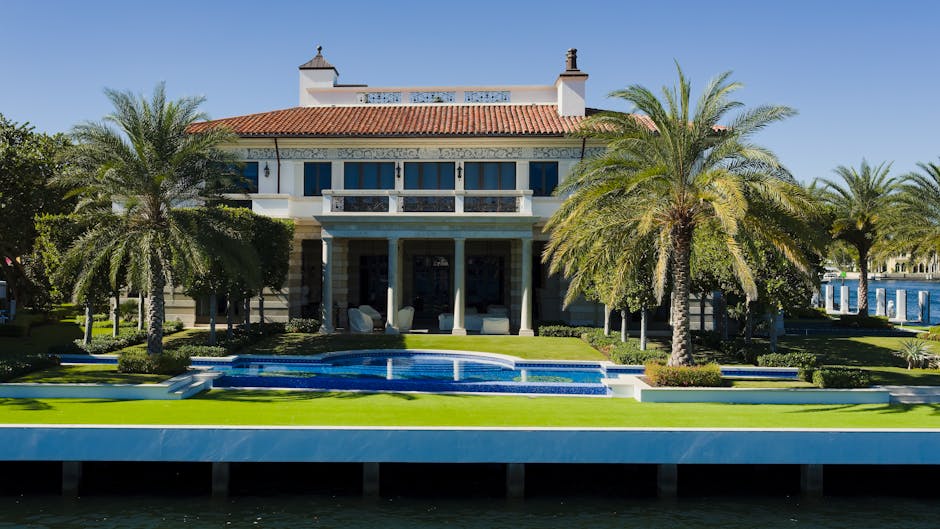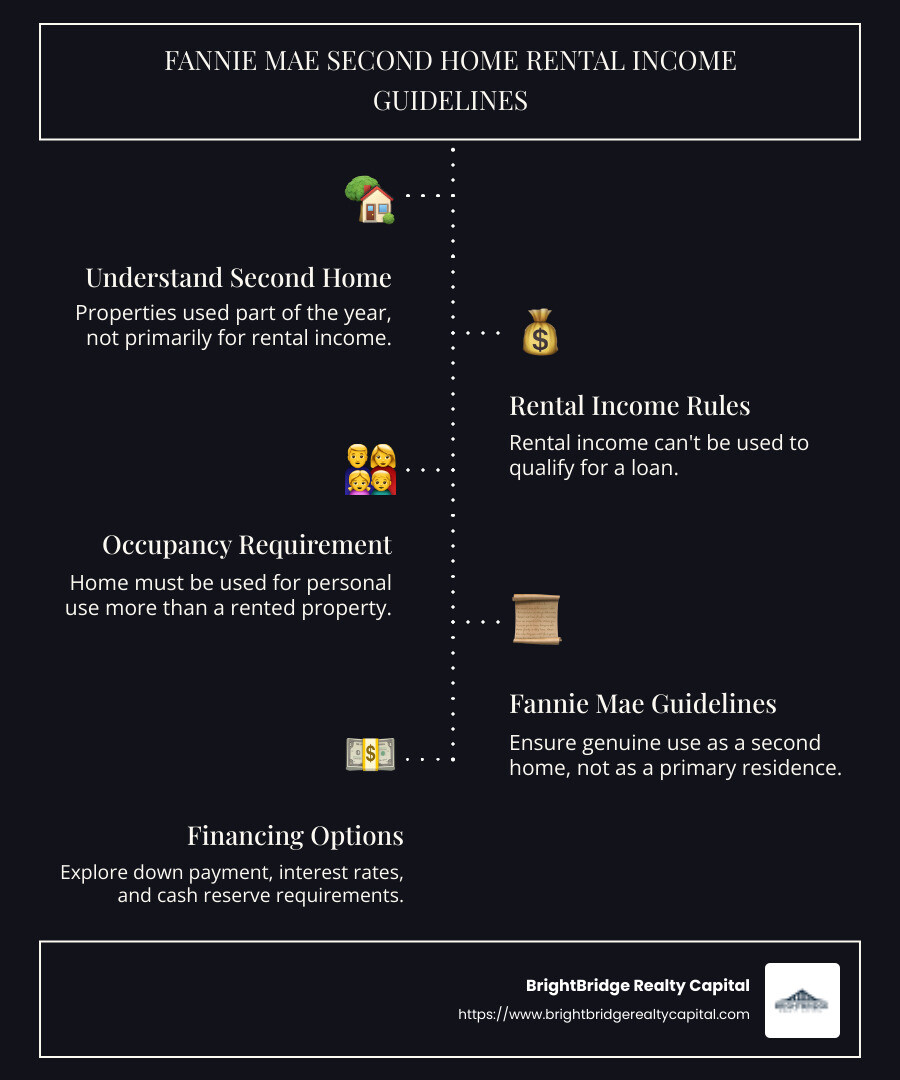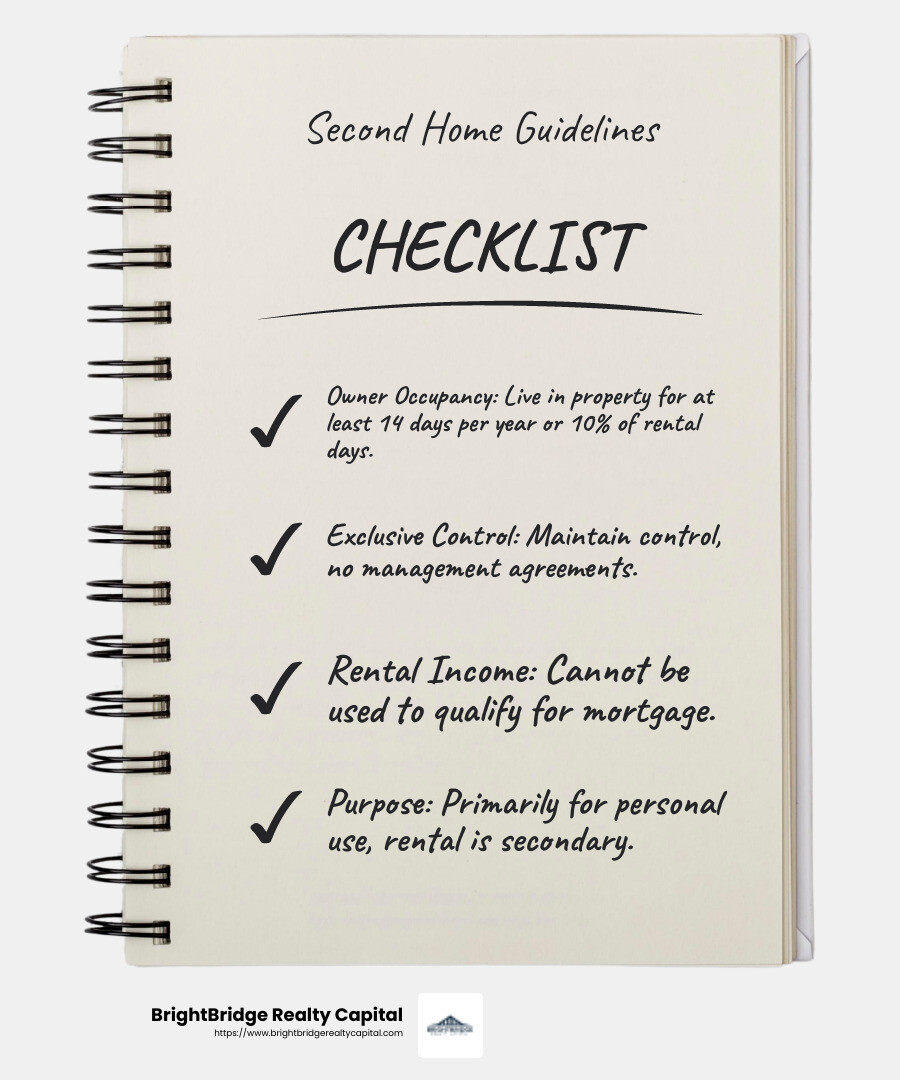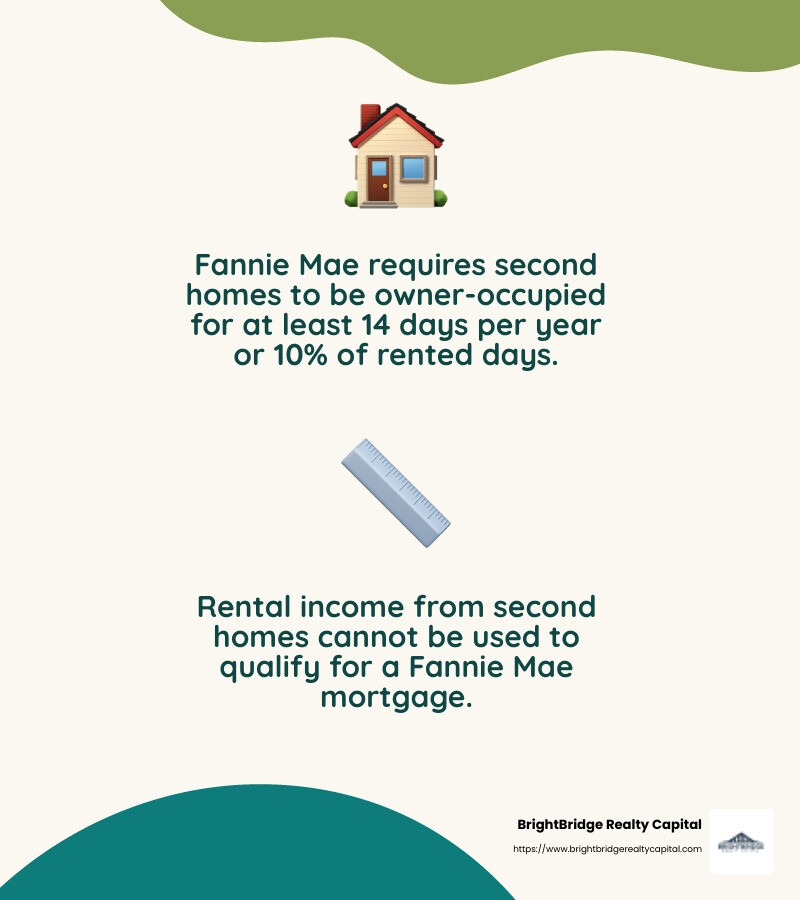Home Away from Home: How Fannie Mae Handles Second Home Rental Income

Fannie Mae second home rental income rules can be puzzling, especially for those eager to make the most of their second property investment. Here's a quick summary to help you understand:
Second Homes: Properties you use part of the year, not primarily for generating rental income.
Rental Income: You can rent out your second home part of the year, but you can't rely on this income to qualify for a loan.
Fannie Mae: Sets guidelines that ensure second homes are genuinely used as claimed, not as primary residences.
Dive into real estate investment, and the concept of second homes often appears as an alluring option. For many, the idea of owning a second home conjures visions of a vacation retreat, a cozy getaway from the hustle and bustle. Yet, with the opportunity to rent it out occasionally, what does this mean for financing?
Enter Fannie Mae, a cornerstone in the American housing finance system. They offer specific guidelines for second homes, particularly when it comes to rental income. While renting is permitted, the critical factor is that said income can't be considered when you're qualifying for a loan. This ensures that these properties remain true second homes and not disguised income-generating machines.
Understanding how Fannie Mae handles second home rental income is essential for any savvy investor looking to maximize their property portfolio while maintaining compliance.

Fannie mae second home rental income definitions:
- conventional vacation rental financing
- freddie mac rental income primary residence
- primary residence mortgage airbnb
Understanding Second Homes
When considering a second home, it's crucial to understand the specific guidelines set by Fannie Mae. These guidelines are designed to ensure that second homes are used as intended and not merely as investment properties. Let's break down the key points:
Second Home Guidelines
Owner Occupancy: A second home must be occupied by the owner for some part of the year. According to Fannie Mae, this means you need to live in the property for at least 14 days per year or 10% of the days it is rented out, whichever is greater. This requirement ensures that the property serves as a genuine second residence.
Exclusive Control: The homeowner must maintain exclusive control over the property. This means you should not enter into agreements that give a management company control over the occupancy. Your second home should feel like your personal retreat, not a business venture.
Rental Income: While you can rent out the property, the rental income cannot be used to qualify for a mortgage. This is a pivotal point in Fannie Mae's guidelines. The property is primarily for personal use, and any rental income is secondary.

Occupancy Requirements
Fannie Mae's occupancy requirements are designed to ensure that second homes are not confused with investment properties. The distinction is important because investment properties have different financing terms.
One-Unit Dwellings: The property must be a one-unit dwelling, such as a house, condo, or apartment. This means you can't purchase a multi-unit building and call it a second home.
Seasonal Use: The property can be seasonal. Whether it's a ski lodge in the mountains or a beach house by the sea, the key is that you use it personally at some point during the year.
Exclusive Control
Maintaining exclusive control over your second home is a non-negotiable requirement. This means you should not have any binding agreements that allow others to manage or occupy the property on your behalf. This exclusive control ensures that the property remains a personal space and not a commercial enterprise.
By understanding these guidelines, you can effectively steer the process of purchasing a second home. Adhering to Fannie Mae's rules ensures that your second home remains a place of personal enjoyment and not a financial liability.
Next, we'll dig into the financing options available for second homes, exploring how factors like down payment and interest rates come into play.
Fannie Mae Second Home Rental Income
Let's explore how Fannie Mae handles second home rental income and what it means for you as a homeowner.
Rental Income and Qualifying Purposes
Fannie Mae's guidelines are clear: while you can rent out your second home, the rental income cannot be used to qualify for the mortgage. This means that when you apply for a loan, you need to demonstrate that you can afford the mortgage payments without relying on potential rental income.
Why is this important? Fannie Mae wants to ensure that second homes are primarily for personal use and not treated as investment properties. This approach helps maintain the distinction between second homes and investment properties, which have different financing terms and requirements.
Occupancy Requirement
To qualify as a second home, Fannie Mae requires that the property is owner-occupied for part of the year. The rule is straightforward: you must live in the home for at least 14 days per year or 10% of the days it is rented out, whichever is greater. This ensures the home is genuinely used as a second residence.
Key Points on Occupancy:
- Personal Use: The primary purpose of the second home should be personal enjoyment, not rental income.
- No Management Control: You should not enter into agreements that give control of the property's occupancy to a management company. This ensures that the property remains under your exclusive control.

By following these guidelines, you can enjoy the benefits of owning a second home while staying compliant with Fannie Mae's rules. Understanding these requirements helps you make informed decisions and avoid potential pitfalls when renting out your second home.
Next, we'll explore the financing options available for second homes, including down payment requirements and interest rates.
Financing Options for Second Homes
When considering a second home, it's crucial to understand the financing options available. These include down payment requirements, interest rates, and cash reserves.
Down Payment
For second homes, the down payment is typically between 10-20% of the property's purchase price. This is slightly higher than the down payment for a primary residence but lower than that for an investment property. Having a larger down payment can sometimes help secure better loan terms.
Interest Rates
Interest rates for second homes are generally on par with or slightly higher than those for primary residences. While they might not be as high as those for investment properties, they can still vary based on market conditions and your creditworthiness. Keeping an eye on current rates and comparing offers from different lenders can ensure you get the best deal.
Cash Reserves
Lenders often require you to have cash reserves to cover two months of mortgage payments for a second home. This requirement helps assure lenders that you can handle the financial responsibility of owning another property. Having these reserves is essential, as it demonstrates your financial stability and preparedness for unexpected expenses.
Understanding these key elements of financing second homes can help you plan effectively and make informed decisions. Next, we'll dig into how second homes differ from investment properties, focusing on their income-generating potential and occupancy requirements.
Differences Between Second Homes and Investment Properties
When it comes to real estate, understanding the distinctions between second homes and investment properties is crucial. These differences impact everything from financing to tax implications.
Investment Properties: Generating Income
Investment properties are primarily purchased to generate income. Whether it's through renting out a single-family home, a condo, or a multi-unit building, the goal is to earn rental income. This income can help cover mortgage payments, property taxes, and other expenses, potentially even providing a profit.
Second homes, on the other hand, are places you intend to use personally. While you can rent them out for part of the year, they must be occupied by you for at least 10% of the days they are rented. This ensures they are not classified as investment properties.
Occupancy: Owner-Occupied vs. Tenant-Occupied
For a property to qualify as a second home under Fannie Mae guidelines, it must be owner-occupied for some portion of the year. This means you, as the owner, must spend time living there. It's not just a vacation rental; it's a place you retreat to, even if only for a few weeks annually.
In contrast, investment properties are generally tenant-occupied. The main focus is on renting the space to others, which means you don't live there. The income generated from these rentals often plays a role in qualifying for financing.
Financing Considerations
The financing terms for second homes and investment properties also differ. Investment properties typically require higher down payments and interest rates due to their higher risk profile. Lenders view them as more risky because they rely on rental income, which can be unpredictable.
On the other hand, financing a second home can be more straightforward. The requirements are often less stringent if you meet the occupancy criteria and don't rely on rental income for loan qualification.
Understanding these distinctions is vital for making informed decisions about purchasing real estate. Whether you're eyeing a cozy cabin for personal use or a multi-unit building to rent out, knowing the differences between second homes and investment properties can guide your investment strategy.
Next, we'll explore some frequently asked questions about Fannie Mae second home rental income, including how rental income factors into loan qualifications and specific occupancy requirements.
Frequently Asked Questions about Fannie Mae Second Home Rental Income
Can I use rental income to qualify for a second home loan?
When you're looking to finance a second home, you might wonder if you can use rental income to help you qualify. According to Fannie Mae guidelines, rental income from a second home cannot be used to qualify for a loan. The idea here is that a second home is primarily for personal use, not for generating income.
This means that even if you plan to rent out your second home part of the year, you can't count that income towards your loan qualifications. However, you can still rent the property out as long as you meet the occupancy requirement.
What are the occupancy requirements for a second home?
Fannie Mae has specific occupancy requirements for what qualifies as a second home. The key requirement is that the property must be owner-occupied for some portion of the year. This means you need to live in the home yourself, not just rent it out to others.
The rule of thumb is that you must occupy the home for at least 10% of the days it's rented out. For instance, if you rent the home for 100 days, you need to live there for at least 10 days. This ensures the property is truly a second home and not just an investment.
How does Fannie Mae define a second home?
According to Fannie Mae, a second home is a property that you own and occupy for part of the year. It's not your primary residence, but it's also not just a rental property. It can be a cozy cabin in the woods, a beach house, or a city condo where you spend weekends.
The property must be a one-unit dwelling, like a house or condo, and you must have exclusive control over it. It's important that the second home isn't part of a timeshare or subject to a management agreement that dictates occupancy.
Understanding these definitions and requirements helps ensure you're making informed decisions about financing a second home. By knowing the rules, you can better steer the process and avoid potential pitfalls. Next, we'll dive into the financing options available for second homes.
Conclusion
Navigating real estate financing can be a complex journey, but with the right partner, it becomes much simpler. At BrightBridge Realty Capital, we pride ourselves on providing a seamless process for securing the funding you need. Whether you're looking to purchase a second home or explore investment opportunities, our team is dedicated to offering quick, flexible solutions custom to your unique needs.
Our expertise in real estate financing allows us to offer competitive rates and fast closings, often within a week. This means you can act swiftly on your investment decisions without unnecessary delays. As a direct lender, we eliminate intermediaries, ensuring a straightforward and efficient experience from start to finish.
If you're ready to explore your options or need guidance on the next steps, we invite you to find more about how we can assist you. Visit our BrightBridge Realty Capital page to learn how we can help bridge the gap in your real estate journey.


